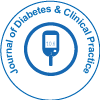开放获取期刊获得更多读者和引用
700 种期刊 和 15,000,000 名读者 每份期刊 获得 25,000 多名读者
抽象的
Risk Factors, Classifications and Pathogenesis of Diabetic Retinopathy
Gudisa Bereda*
Diabetic retinopathy, a microangiopathy affecting all of the small retinal vessels, such as arterioles, capillaries and venules, is characterized by increased vascular permeability, ocular haemorrhages, lipid exudate, by vascular closure mediated by the development of new vessels on the retina and the posterior vitreous surface. The most relevant risk factors for the development of diabetic retinopathy are the duration of the disease, poor glycemic control (high glycosylated hemoglobin levels) and the presence of hypertension. However, the impact of bloodglucose control in the development of diabetic retinopathy is stronger that the impact of blood-pressure control. Proliferative diabetic retinopathy is characterized by the hallmark feature of pathologic preretinal neovascularization. Inflammation is a nonspecific response to injury that includes a variety of functional and molecular mediators, including recruitment and activation of leukocytes. Inflammation typically has beneficial effects on an acute basis, but can have undesirable effects if persisting chronically. The increased expression of many inflammatory proteins is regulated at the level of gene transcription through the activation of proinflammatory transcription factors, including nuclear factor kappa B.

 English
English  Spanish
Spanish  Russian
Russian  German
German  French
French  Japanese
Japanese  Portuguese
Portuguese  Hindi
Hindi